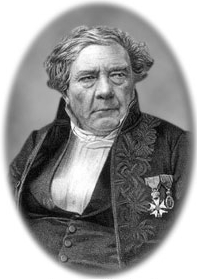Jacques Babinet
| Jacques Babinet | |
|---|---|
 |
|
| Born |
5 March 1794 Lusignan, France |
| Died | 21 October 1872 (aged 78) Paris, France |
| Known for | Invention of polariscope and an optical goniometer |
Jacques Babinet (French: [babinɛ]; 5 March 1794 – 21 October 1872) was a French physicist, mathematician, and astronomer who is best known for his contributions to optics.
His father was Jean Babinet and mother, Marie‐Anne Félicité Bonneau du Chesn. Babinet started his studies at the Lycée Napoléon, but was persuaded to abandon a legal education for the pursuit of science. A graduate of the École Polytechnique, which he left in 1812 for the Military School at Metz, he was later a professor at the Sorbonne and at the Collège de France. In 1840, he was elected as a member of the Académie Royale des Sciences. He was also an astronomer of the Bureau des Longitudes.
Among Babinet's accomplishments are the 1827 standardization of the Ångström unit for measuring light using the red Cadmium line's wavelength, and the principle (Babinet's principle) that similar diffraction patterns are produced by two complementary screens. He was the first to suggest using wavelengths of light to standardise measurements. His idea was first used between 1960 and 1983, when a meter was defined as a wavelength of light from krypton gas.
Babinet was interested in the optical properties of minerals throughout his career. He designed and created many scientific instruments utilized to determine crystalline structure and polarization properties, including the polariscope and an optical goniometer to measure refractive indices. The Babinet compensator, an accessory useful in polarized light microscopy, was built with twin, opposed quartz wedges having mutually perpendicular crystallographic axes, and is still widely employed in microscopy. This design avoids the problems inherent in the basic quartz wedge, where the zero reading coincides with the thin end of the wedge, which is often lost when grinding the plate during manufacture.
...
Wikipedia
